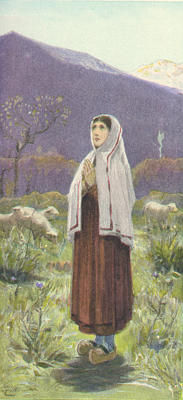
Notre Dame's Grotto / by Dorothy V. Corson

News of Lourdes Reaches the New World
In 1847 the Bishops in the United States petitioned Pope Pius IX to declare the Blessed Mother Patroness of the United States under her title of the Immaculate Conception. On Dec. 8, 1854, Pope Pius IX proclaimed the dogma of the Immaculate Conception in Rome.
Five months later, on April 24, 1855, the cornerstone was blessed and the Academy of St. Mary's of the Immaculate Conception(15) was established. Father Sorin had deeded fifty acres of land, and had given a grant of $5000 for new buildings to the Sisters of the Holy Cross, so they could move their school in Bertrand, Michigan closer to Notre Dame. The convent and school were reestablished on the banks of the St. Joseph River where it is known today as Saint Mary's College.
 Three years later, on the 11th of February, 1858, the world began to hear about the apparitions of the Virgin Mary seen by Bernadette at the Grotto of Massabielle in Lourdes France. The dogma of the Immaculate Conception, proclaimed by Pope Pius IX, was reputed to be a doctrine unknown to the unschooled Bernadette. Yet she said, "the beautiful lady said to her: 'I am the Immaculate Conception.'" In 1870 Notre Dame's, Ave Maria, detailed the phenomenon:
Three years later, on the 11th of February, 1858, the world began to hear about the apparitions of the Virgin Mary seen by Bernadette at the Grotto of Massabielle in Lourdes France. The dogma of the Immaculate Conception, proclaimed by Pope Pius IX, was reputed to be a doctrine unknown to the unschooled Bernadette. Yet she said, "the beautiful lady said to her: 'I am the Immaculate Conception.'" In 1870 Notre Dame's, Ave Maria, detailed the phenomenon:
The simple facts are these. On the 11th of February, 1858, a humble, ignorant peasant child, named Bernadette Soubirous, being sent by her parents, together with her two companions, to fetch some dead wood by a mountain stream, close to a grotto, known in the country by the name of "The Grotto of Massabielle," suddenly saw in an inaccessible place an apparition, clothed in white and radiant beyond description. This apparition returned at stated times, as it had promised, on eighteen different occasions; it spoke to the child, commanding her to tell the clergy to have a chapel built on the spot; and at its word a miraculous spring burst forth under the hands of the child, in the presence of hundreds of spectators, from the dry hard rock of the grotto, which miraculous source gave sight to the blind, feet to the lame, and healing to the sick of all ages, conditions, and maladies. These miraculous appearances were doubted by the clergy, roused the opposition of the Government, and convulsed the whole country for eight months, when a word from the Emperor left the people in peace to follow their own convictions. From that time until now the number of pilgrims and of miraculous cures have been steadily increasing, and a very beautiful church has been built on the spot indicated by the vision.
The Ave Maria also included a review of a book written about it:

Henri Lasserre, Bernadette's historian and author of Our Lady of Lourdes , has taken almost incredible trouble to verify every fact which he relates. He has given the names and addresses of a host of witnesses both to the original facts and to the cures effected in consequence. The most incredulous man amongst us would be compelled, in the face of such evidence, to hesitate before declaring the whole matter to be the offspring of imagination; while the marvelous disinterestedness and simplicity of the peasant girl and her family, to whom these singular revelations were made, go far to set aside the opposite assertion "that the whole thing was an intrigue, and a pretext to get money out of the credulous." Equally remarkable are the extreme reticence and prudence of the clergy, and especially the Bishop, who was one of the very last to give in his adhesion to the popular belief, and for the first few months utterly forbade his clergy to take any part in the proceedings, or even to visit the grotto. The cry of priestcraft, therefore, falls equally to the ground.(16)
The Blessed Mother appeared to Bernadette in a humble place, a lowly cave, as Christ was born in a stable. She was a simple peasant girl; even the doctrine of the Trinity was unknown to her. Her use of the phrase, "I am the Immaculate Conception," was to baffle the community, the priests, and those who persecuted her, but they could not shake her faith. She would not change her story. From that moment on Lourdes became a mecca for pilgrimages by the devout and the faithful the world over. News of it spread across the continent into the new world and onto the campuses of Notre Dame and St. Mary's.